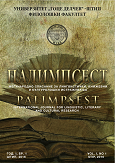WOOD CARVING – TRADITIONAL ART EMBEDDED IN THE HISTORIC OBJECTS
WOOD CARVING – TRADITIONAL ART EMBEDDED IN THE HISTORIC OBJECTS
Author(s): Petar Namichev, Ekaterina Namicheva TodorovskaSubject(s): Cultural history, Architecture, Ethnohistory
Published by: Универзитет »Гоце Делчев« - Штип
Keywords: carving; chisel; ceiling; musandra; deep carving; technique; historic buildings; wood.
Summary/Abstract: The protection of traditional crafts represents one of the goals of Intangible Cultural Heritage to be safeguarded, as defined in the UNESCO 2003 Convention. In the field of architecture, traditional carving is embodied in construction techniques in the interior decoration and ornamentation of historic buildings. The architectural and artistic value of the historic objects means protection of their intangible aspect which is to be kept and nurtured for future generations. The wood carving technique in Macedonia at the same time had inclination in embellishing the ecclesiastic decoration, and also in the profane buildings. In the profane buildings the decoration was made for the ceilings, side boards (musandras), chests (dolap) columns, furniture but also for decorative objects. In Macedonia a great number of wood carving masters had specialized for decorating the urban houses during the 18th until 20th centuries. The progress of the wood carving craft was connected with individual work of the masters, and rarely to a skilled group –tajfa, until the mid-20th century when wood carving firms were created to carry on the old skill into contemporary times. Today the methods are changing regarding the traditional ways of carving the wooden pieces and increased changes in the building technology. The knowledge of the local crafts is broadly forgotten regarding the traditional methods by the new generation of wood carvers. Through knowledge of the old local ornaments which are applied in the craft, the conservation methodology of the carving which consists of the use of traditional ornaments, means conveying of the traditional methods to the new generation of craftsmen. Nurturing the traditional way of woodcarving, represents one integrated process of transferring the skills of the craft as human art and part of the traditional architecture.
Journal: Палимпсест, Меѓународно списание за лингвистички, книжевни и културолошки истражувања
- Issue Year: 3/2018
- Issue No: 6
- Page Range: 227-239
- Page Count: 13
- Language: English

